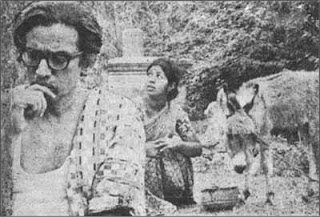
Koyna Nagar (1967) In English
Priya (1969) John's Diploma film at FTII, Pune, in Hindi
Hides and Strings (1969) In English
Vidhyarthigale Ithile Ithile 1971
(This Way Students)
John Abraham's first feature film, made during his stay in Madras as a group co-operative effort.
During a football match at school some schoolboy breaks the statue of the school's founder. Raju is held responsible for this. He is given two choices, either pay for the damage or face expulsion. The boys get together and earn the money by polishing boots, selling lottery tickets and so on. The school's principal gets impressed with this and the management decides to repair the statue with their own money and spend the money earned by the boys for an excursion. Shortly afterwards during another football match they break the statue again.
Direction: John Abraham
Screenplay: M Azad
Cast: Adoor Bhasi, Manorama, S V Ranga Rao, Jayabharati, S P Pillai
Cinematography: K Ramachandra Babu
Music: M B Srinivasan
Agraharathil Kazhuthai 1977
(Donkey in A Brahmin Village)
John's second film, Agraharathil Kazhuthai made in Tamil, is a hard hitting satire on the brahminical bigotry and superstition, where a donkey becomes the central character.
A donkey strays into a village dominated by the upper cast Brahmins. Prof Narayana Swamy decides to keep it at his house. He appoints a mute girl to look after the donkey. The entire village turns against the donkey and his caretaker. When the girl's stillborn baby is deposited outside a temple, the donkey is blamed and is killed.
After the death of the donkey some miracles start happening in the village. People start believing that it is the donkey that brought about all the miracles and starts worshipping the dead body of the donkey. The villagers give a ritual funeral to the donkey by burning it. In a symbolic end, fire spreads and engulfs the entire village. Only the professor and the girl survive.
Even though this film won a National award, Doordarshan was forced to cancel a scheduled a TV screening and the Tamil press ignored the film as the Brahmin bigots tried to have the film banned.
Direction & Co-Screenplay: John Abraham
Co-Screenplay: Venkat Swaminathan
Cast: M B Srinivasan, Swathi, Savitri, Raman Veeraraghavan
Cinematography: K Ramachandra Babu
Editing: Ravi
Music: M B Srinivasan
Cheriyachente Kroora Krithyangal - 1979
(Cruelties of Cheriyachan)
John, having deep knowledge in Marxist and Christian traditions, made his third film, Cheriyachente Kroora Krithyangal using Christian and feudal symbols in the backdrop of Kuttanadu, his home land. When he attacked the traditionalists in his earlier film Agraharathil Kazhutai, in Cheriyachente Kroora Krithyangal, he attacked the feudal system and police atrocities during the feudal period.
Cheriyachan, a landlord feels threatened by industrialisation and the leftist activities. But when he witnesses the police atrocities on poor peasants, feel of guilt engulfs him and he feels responsible for the guilt of his entire class. He is last seen up a coconut tree trying to keep away from the police. A peasant's movement against the feudal system also lies in the backdrop of the film.
Here, the feudal lord is shown as a frightened victim of history in contradiction to the normal characterisation as a stereotypical villain.
Direction & Screenplay: John Abraham
Cast: Adoor Bhsdi, Kaviyoor Ponnamma, Poornima Jayaram, Abraham Joseph, Venu
Cinematography: Madhu Ambat
Music: Johnson
Amma Ariyan - 1979
(Report to Mother)
The first film of the Odessa Collective and the last by John Abraham, Amma Ariyan was made as a people's film by the money obtained from the ordinary people of Kerala.
Purushan sets out for Delhi for his research, promising his mother to write to her wherever he is. The film is in the form of a letter written by Purushan to his mother. On his way he finds a dead body, which he later identifies as that of Hari's. Purushan decides to go Hari's house to inform his mother about her son's death. On his way he meets some of Hari's friends, and the character Hari in the film unfolds as the memories of these friends about him, mostly conflicting. They too join Hari in his journey. As they reach Hari's house, the small group that started the journey develops into a crowd of young men. Finally they inform Hari's mother about her son's death.
A complex film, Amma Ariyan is made in a documentary form interweaving fact and fiction. The political history of Kerala is narrated during the film occasionally and also John filmed actual leftist strikes for Amma Ariyan.
Direction & Screenplay: John Abraham
Cast: Joy Mathew, Maji Venkitesh, Nilambur Balan, Harinarayan
Cinematography: Venu
Editing: Beena
Music: Sunitha







